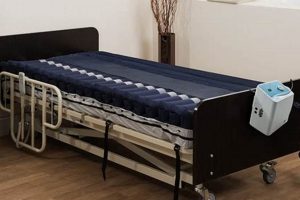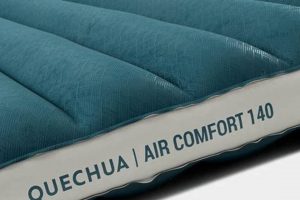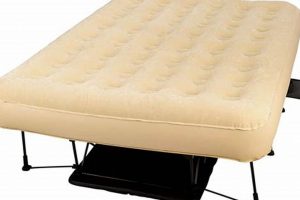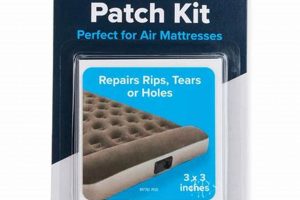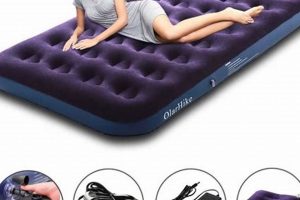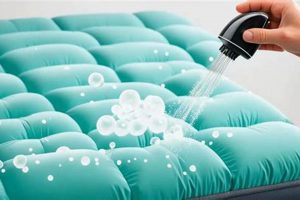A device employed to inflate air mattresses utilizing electrical power. This mechanism rapidly introduces air into the mattress, facilitating quick setup for temporary sleeping arrangements or recreational use. Typical units consist of an electric motor that drives a fan or piston, forcing air through a nozzle and into the mattress valve.
These devices offer convenience and efficiency compared to manual inflation methods. Historically, inflating air mattresses required substantial physical effort using hand pumps or foot pumps. The advent of electrical models significantly reduced the time and exertion needed, rendering them a valuable asset for camping, guest accommodations, and situations requiring rapid inflation.
Subsequent sections will explore various models, their technical specifications, operational considerations, and factors relevant to selecting an appropriate inflation device for specific air mattress applications.
Essential Usage Guidelines
Proper employment and maintenance practices are crucial for maximizing device lifespan and ensuring optimal performance during inflation tasks.
Tip 1: Verify Voltage Compatibility: Prior to operation, confirm the electrical voltage of the power source aligns with the specifications of the device to prevent damage or malfunction.
Tip 2: Inspect the Nozzle and Valve Connection: Ensure a secure and airtight connection between the device nozzle and the air mattress valve to minimize air leakage during the inflation process.
Tip 3: Avoid Over-Inflation: Adhere to the manufacturer’s recommended pressure levels to prevent seam stress and potential rupture of the air mattress. Use a pressure gauge if the pump lacks an automatic shut-off function.
Tip 4: Regularly Clean the Air Filter: Many units incorporate an air filter to prevent debris from entering the pump mechanism. Routine cleaning extends the operational life of the device and maintains optimal airflow.
Tip 5: Store in a Dry Environment: When not in use, store the device in a dry location to prevent corrosion or electrical component degradation due to moisture exposure.
Tip 6: Allow for Cooling Periods: Prolonged continuous operation can lead to overheating. Incorporate brief cooling periods during extended inflation tasks to prevent damage to the motor.
Tip 7: Examine Power Cord Integrity: Prior to each use, meticulously inspect the power cord for any signs of fraying, damage, or exposed wires. A compromised power cord presents a significant safety hazard and must be addressed before operation.
Adhering to these guidelines promotes efficient and safe operation, ultimately prolonging the functional lifespan of the inflation device and preserving the integrity of the associated air mattress.
The subsequent section will delve into common troubleshooting procedures and maintenance practices to address potential operational issues.
1. Inflation Speed
Inflation speed, as it relates to electric pumps designed for air mattresses, is a primary performance metric reflecting the time required to fully inflate a mattress to its optimal pressure. This parameter directly impacts user convenience and preparedness, particularly in situations where rapid setup is essential.
- Pump Motor Power
The electrical motor driving the pump directly correlates with inflation speed. Motors with higher wattage or horsepower ratings typically deliver greater airflow, resulting in faster inflation times. Example: A pump with a 150W motor inflates a standard queen-size air mattress in approximately 3 minutes, while a 100W model may require 5-7 minutes.
- Airflow Rate (CFM/LPM)
Airflow rate, measured in cubic feet per minute (CFM) or liters per minute (LPM), quantifies the volume of air the pump displaces. Higher airflow rates translate to quicker inflation. Specification sheets routinely detail the pump’s maximum airflow capacity. A pump rated at 10 CFM will inflate the mattress faster than one rated at 5 CFM, assuming consistent valve design and mattress volume.
- Pump Design and Efficiency
The internal design of the pump, including the fan blade configuration or piston mechanism, influences efficiency. Well-designed pumps minimize air leakage and maximize the transfer of air into the mattress. Diaphragm pumps, for instance, may offer a more consistent flow rate than simpler fan-based designs, potentially impacting inflation speed in specific mattress types.
- Valve Compatibility and Seal
The effectiveness of the seal between the pump nozzle and the air mattress valve is crucial. Ill-fitting nozzles or damaged valves create air leaks, diminishing inflation efficiency and extending the overall inflation time. Universal nozzle adapters are often included to accommodate various valve designs, but their sealing performance can vary.
These interconnected facets highlight the multifaceted nature of inflation speed. While motor power and airflow rate are primary determinants, the pump’s internal design and the integrity of the valve connection are equally critical. Ultimately, selecting a model with an optimized combination of these features ensures efficient and timely inflation of air mattresses for diverse applications.
2. Power Source
The power source constitutes an indispensable element of any air mattress electric pump, fundamentally dictating its operational capabilities and application scenarios. The energy input methodtypically alternating current (AC), direct current (DC), or integrated batterydirectly influences the pump’s portability, inflation capacity, and suitability for specific environments. A pump’s reliance on a specific energy source dictates its operational availability; for example, a 120V AC pump proves effective within proximity to standard household outlets, while a 12V DC variant enables operation within vehicles or using portable power stations. Absent a compatible energy input, the electric pump remains inoperative, thus underscoring the critical dependency.
Divergent power source types confer distinct advantages and disadvantages. AC-powered models, commonly found in residential settings, often deliver higher power output, leading to faster inflation cycles. However, this advantage is counterbalanced by their inherent immobility, restricting usage to areas with readily accessible electrical outlets. DC-powered models, frequently employed in camping and outdoor recreational pursuits, prioritize portability and adaptability, permitting operation from car batteries or portable power packs. This inherent flexibility may be offset by a potential reduction in inflation power compared to their AC counterparts. Battery-operated air mattress pumps offer the ultimate portability but may suffer from limited run time and reduced power.
Integrated rechargeable batteries offer a compromise, providing cordless operation with the convenience of recharging via AC or DC sources.
Comprehending the ramifications of power source options enables informed selection aligned with intended usage. A home-based inflation requirement might favor an AC-powered pump, optimizing inflation speed and efficiency. Conversely, an outdoor enthusiast will likely prioritize a DC-powered or battery-operated unit, accepting potential performance trade-offs for enhanced portability. The optimal choice balances energy source accessibility, performance characteristics, and intended operational environment, ensuring the air mattress pump functions effectively under diverse conditions.
3. Nozzle Compatibility
Nozzle compatibility, concerning air mattress electric pumps, directly influences inflation efficiency and operational effectiveness. A secure and properly fitted nozzle is paramount for establishing an airtight connection between the pump and the air mattress valve, minimizing air leakage and ensuring rapid, complete inflation.
- Valve Type Variance
Air mattresses utilize diverse valve designs, including Boston valves, pinch valves, and stem valves. Each design necessitates a compatible nozzle interface to achieve a proper seal. A mismatch can result in significant air leakage, prolonging inflation time or rendering the pump entirely ineffective. Manufacturers often provide multiple nozzle attachments to accommodate various valve types.
- Nozzle Material and Construction
The nozzle’s material composition affects its durability and sealing properties. Rigid plastic nozzles offer structural integrity but may lack the flexibility required for optimal sealing on certain valve types. Conversely, flexible rubber or silicone nozzles conform more readily to valve irregularities, enhancing the airtight seal. However, these materials may be prone to degradation over time.
- Universal Adapters and Their Limitations
Universal adapters, designed to fit a range of valve types, represent a common solution. However, their effectiveness varies. Adapters that rely on friction fitting may be prone to slippage or leakage under pressure. More sophisticated adapters employ threaded connections or locking mechanisms to provide a more secure and reliable seal. The quality of the adapter significantly influences inflation performance.
- Impact on Inflation Time and Pressure
An incompatible or poorly fitted nozzle directly affects inflation efficiency. Air leakage reduces the pump’s effective airflow rate, extending inflation time and potentially preventing the mattress from reaching its optimal pressure. Consistent pressure is critical for maintaining mattress firmness and support. A secure nozzle connection is essential for achieving and sustaining the desired inflation level.
The intricacies of nozzle compatibility highlight its importance in the context of air mattress electric pumps. Selecting a pump with an array of high-quality, appropriately sized nozzles ensures adaptability to diverse air mattress valve designs. Prioritizing nozzle material, construction, and secure connection mechanisms optimizes inflation efficiency and contributes to prolonged mattress lifespan.
4. Portability
Portability significantly influences the utility and versatility of air mattress electric pumps, determining their suitability for various applications beyond stationary home use. The ease with which a pump can be transported and deployed directly impacts its value in scenarios such as camping, travel, and temporary accommodation where access to fixed power sources may be limited or unavailable.
- Size and Weight Considerations
The physical dimensions and mass of the pump dictate its ease of transport. Compact, lightweight models are readily stowed in luggage or backpacks, facilitating convenient travel. Larger, heavier pumps, while potentially offering greater power, compromise portability and may be less practical for scenarios requiring frequent relocation. For example, a pump weighing under 2 pounds is generally preferable for backpacking compared to a 5-pound model.
- Power Source Dependency
Portability is intrinsically linked to the pump’s power source requirements. Pumps relying solely on AC power are tethered to electrical outlets, severely restricting their use in remote locations. Models that operate on DC power (e.g., 12V car adapters) or incorporate rechargeable batteries offer greater flexibility, enabling inflation in vehicles or areas lacking electrical infrastructure. A pump with both AC and DC power options provides maximum versatility.
- Cord Management and Storage
The design of the cord management system contributes to overall portability. Pumps with retractable cords or integrated storage compartments minimize clutter and prevent damage during transport. A poorly designed cord can become tangled or damaged, hindering deployment and potentially compromising the pump’s functionality. Secure cord storage is essential for maintaining portability.
- Durability and Protective Features
Portable pumps are often subjected to harsher handling conditions compared to stationary models. Durable construction and protective features, such as impact-resistant casings, safeguard the pump against damage during transport. A pump designed for outdoor use should withstand potential bumps, drops, and exposure to environmental elements. Robust construction enhances the pump’s longevity and reliability in portable applications.
The interplay of size, weight, power source, cord management, and durability determines the practical portability of an air mattress electric pump. Selecting a model that prioritizes these factors enhances its usability across a wider range of environments, transforming it from a stationary appliance into a versatile tool for inflation needs wherever they may arise.
5. Noise Level
Noise level, measured in decibels (dB), represents a significant operational characteristic of any air mattress electric pump. The sound emitted during inflation directly affects user experience, particularly in noise-sensitive environments such as bedrooms, apartments, or campgrounds. The noise generated stems primarily from the pump’s internal motor and fan mechanism, compounded by the resonance of the pump’s housing. For example, a pump operating at 80 dB can be disruptive, especially during late-night use or in close proximity to sleeping individuals. This characteristic can directly impact customer satisfaction and product suitability for specific applications.
Excessive noise levels can detract from the convenience and utility of an electric pump, particularly when used in shared living spaces or during travel. Pump designs incorporating noise-dampening materials, vibration isolation mounts, and optimized fan blade geometries can mitigate sound emissions. Some models feature noise reduction technologies that lower the decibel output, allowing for quieter inflation. Consider a scenario where a guest arrives late in the evening; a l
ow-noise pump minimizes disturbance, ensuring a more comfortable experience. Conversely, a loud pump could create unwelcome noise pollution, impacting both the user and surrounding individuals.
In conclusion, noise level is a critical factor in evaluating the overall suitability of an air mattress electric pump. Lower decibel ratings generally indicate a more refined and user-friendly design. Understanding the noise characteristics of different models allows for informed purchasing decisions, optimizing comfort and minimizing potential disruption in various usage scenarios. Manufacturers often specify noise levels in product specifications, enabling consumers to prioritize this parameter based on their individual needs and environmental considerations. Further research on noise reduction technologies in small motor design could lead to even quieter and more versatile inflation devices.
Frequently Asked Questions
This section addresses common inquiries regarding air mattress electric pumps, providing concise and factual responses to facilitate informed decision-making and proper device utilization.
Question 1: What is the typical operational lifespan of an air mattress electric pump?
The operational lifespan varies depending on usage frequency, maintenance practices, and build quality. High-quality models, used according to manufacturer guidelines and properly maintained, can last for several years. Regular cleaning and appropriate storage contribute to longevity.
Question 2: Can any air mattress electric pump be used with any air mattress?
No. Valve compatibility is essential. Many pumps include multiple nozzle adapters to accommodate different valve designs. However, it is imperative to verify compatibility before attempting inflation to prevent damage to the pump or the mattress valve.
Question 3: What safety precautions should be observed when operating an air mattress electric pump?
Verify voltage compatibility before plugging in the device. Never operate a damaged pump or power cord. Do not leave the pump unattended during operation. Avoid over-inflation of the air mattress, as this can lead to seam failure and potential injury.
Question 4: Is it possible to repair a malfunctioning air mattress electric pump?
Minor issues, such as clogged air filters, may be addressed with basic maintenance. However, internal component failures typically require specialized repair or replacement of the entire unit. Consult the manufacturer’s warranty or seek professional assistance for complex repairs.
Question 5: What is the recommended storage procedure for an air mattress electric pump when not in use?
Store the pump in a dry, clean environment away from extreme temperatures and direct sunlight. Ensure the power cord is properly coiled or stored to prevent damage. Retain nozzle adapters and the owner’s manual for future reference.
Question 6: How does ambient temperature affect the performance of an air mattress electric pump?
Extreme temperatures can impact pump performance. High temperatures may cause the motor to overheat, reducing efficiency and potentially leading to premature failure. Cold temperatures can stiffen internal components, affecting airflow. Operate the pump within its specified temperature range for optimal performance.
Proper selection, usage, and maintenance are critical for maximizing the utility and lifespan of air mattress electric pumps. Adhering to these guidelines ensures efficient and safe operation across diverse applications.
The subsequent section will delve into selecting the optimal air mattress electric pump based on specific requirements.
Conclusion
This exploration of the air mattress electric pump has illuminated its multifaceted nature, extending beyond a simple inflation device. The analysis encompassed operational principles, usage guidelines, factors influencing performance, and essential considerations for selection. A comprehensive understanding of valve compatibility, power source options, portability limitations, and noise level variances is critical for informed procurement and effective application. The lifespan and reliability of these pumps are contingent on adherence to recommended maintenance procedures and appropriate storage practices.
The ongoing demand for rapid and convenient inflation solutions ensures the continued relevance of the air mattress electric pump. Technological advancements may yield more efficient, quieter, and more durable models, further enhancing their utility across diverse settings. Careful evaluation of individual needs and operating environments remains paramount in leveraging the full potential of this essential device, maximizing its contribution to convenience and comfort. Further investment in design and materials research is crucial to advancing its technological design and efficiency.


